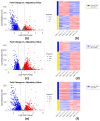Transcriptomic Alterations of Canine Histiocytic Sarcoma Cells in Response to Different Stressors
- PMID: 40724877
- PMCID: PMC12294338
- DOI: 10.3390/ijms26146629
Transcriptomic Alterations of Canine Histiocytic Sarcoma Cells in Response to Different Stressors
Abstract
Canine histiocytic sarcoma (HS) is a rare tumor with a poor prognosis. Rapid tumor growth often causes central hypoxia and starvation, impacting tumor progression. In the present study, HS cells were cultured under hypoxia and starvation for 1 and 3 days, simulating intermediate and central tumor zones, respectively. Cells were counted at each time point, followed by RNAseq analysis. Only hypoxia significantly reduced the cell number (p < 0.05). Short-term hypoxia altered 1645 differentially expressed genes (DEGs). Upregulated genes belonged to vasculature development, and downregulated genes to cell cycle processes. Short-term starvation affected 157 genes, mainly involving responses to stimuli. Prolonged hypoxia and starvation induced 1301 and 836 DEGs, respectively. Prolonged hypoxia upregulated genes mainly involved in immune responses, response to stimulus, adhesion, and angiogenesis. Prolonged starvation upregulated genes associated with signaling, adhesion, circulatory system development, and response to stimulus. Lipid metabolism and cell cycle pathways were downregulated under prolonged hypoxia and starvation, respectively. KEGG "pathways in cancer" were enriched under all conditions (adjusted p-values < 0.05). These findings indicate that hypoxia and starvation significantly alter the expression of genes involved in tumor progression. Further studies, namely post-translational analyses, are needed to elucidate the functional impact of these changes and identify potential therapeutic targets.
Keywords: RNA sequencing; hypoxia; metabolism; starvation; stress; tumor zones.
Conflict of interest statement
The authors declare no conflicts of interest.
Figures









Similar articles
-
Molecular Classification Based on the Gene Expression Profiles in Canine Histiocytic Sarcoma Cells.Vet Comp Oncol. 2025 Sep;23(3):465-475. doi: 10.1111/vco.13071. Epub 2025 Jun 11. Vet Comp Oncol. 2025. PMID: 40500939 Free PMC article.
-
Transcriptomic profiling of dorsal root ganglia in atopic and healthy dogs: A comparative RNA sequencing study with implications in cutaneous itch research.Vet Dermatol. 2025 Aug;36(4):401-411. doi: 10.1111/vde.13324. Epub 2025 Jan 27. Vet Dermatol. 2025. PMID: 39868604 Free PMC article.
-
Development of a Starvation Response-Based Model and Its Application in Prognostic Assessment of Liver Hepatocellular Carcinoma.Mediators Inflamm. 2025 Jul 7;2025:8828435. doi: 10.1155/mi/8828435. eCollection 2025. Mediators Inflamm. 2025. PMID: 40662145 Free PMC article.
-
A rapid and systematic review of the clinical effectiveness and cost-effectiveness of topotecan for ovarian cancer.Health Technol Assess. 2001;5(28):1-110. doi: 10.3310/hta5280. Health Technol Assess. 2001. PMID: 11701100
-
Systemic pharmacological treatments for chronic plaque psoriasis: a network meta-analysis.Cochrane Database Syst Rev. 2021 Apr 19;4(4):CD011535. doi: 10.1002/14651858.CD011535.pub4. Cochrane Database Syst Rev. 2021. Update in: Cochrane Database Syst Rev. 2022 May 23;5:CD011535. doi: 10.1002/14651858.CD011535.pub5. PMID: 33871055 Free PMC article. Updated.
References
-
- Toyoda I., Vernau W., Sturges B.K., Vernau K.M., Rossmeisl J., Zimmerman K., Crowe C.M., Woolard K., Giuffride M., Higgins R., et al. Clinicopathological characteristics of histiocytic sarcoma affecting the central nervous system in dogs. J. Vet. Intern. Med. 2020;34:828–837. doi: 10.1111/jvim.15673. - DOI - PMC - PubMed
MeSH terms
Grants and funding
LinkOut - more resources
Full Text Sources

